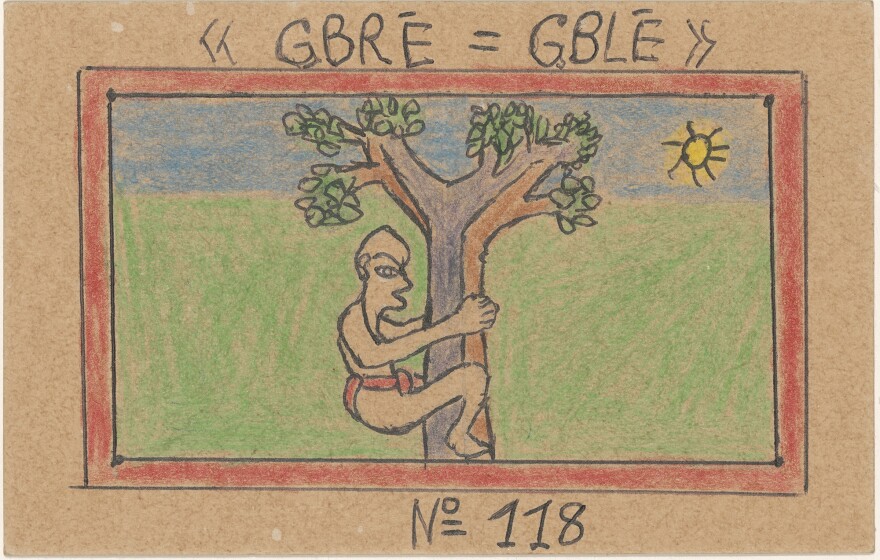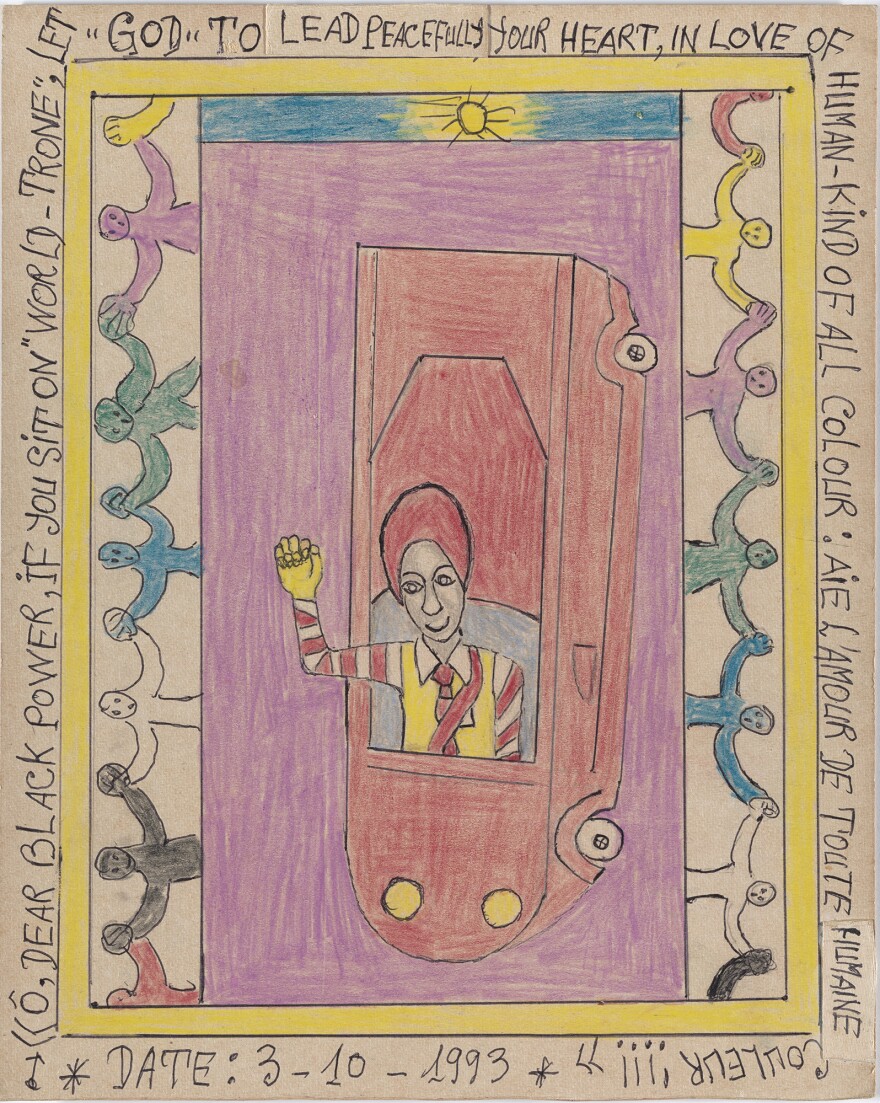In 1948, the late Ivoirian artist Frédéric Bruly Bouabré had a vision that would change his life. On his way to work as a civil servant in the colonial navy in Dakar, then the capital of French West Africa, he said he saw "seven colored suns" creating a "circle of beauty around their 'mother-sun.' "

The experience, he said, inspired him to begin making art as a way to document the lives of his Bété people, an ethnic group in the Ivory Coast known for being fierce hunters and warriors. More than 1,000 of his writings and drawings are on display until August 13 as part of Frédéric Bruly Bouabré: World Unbound, an exhibit at The Museum of Modern Art in New York City. It is MoMA's first solo exhibition of an artist from West Africa.
Bouabré, who died in 2014 at the age of 90, used crayons, ballpoint pen and colored pencil to make simple and colorful illustrations on materials such as discarded cardboard and hair product packaging. He drew everyday objects from his Bété culture like pots, animals and cigarettes; pictographs for the Bété language, which did not have a writing system; and images gleaned from his spiritual visions.
Despite his visionary inspiration, Bouabré says he was merely drawing the world as he saw it. "I do not work from my imagination," Bouabré once said. "I observe, and what I see delights me."
NPR talks to Smooth Nzewi, the curator of the exhibit at MoMA, about Bouabré's life and work. This interview has been edited for length and clarity.

Bouabré said when he experienced that vision in 1948, his name would also be changed to "Cheik Nadro, the Revealer" — which he said means "the one who never forgets." Did he see himself as a supernatural being?

He saw himself as more of a single artistic genius. In 1991, he drew a self-portrait called Mythologie Bété "Génie Guié Guié Guié" "Génie Couvert D'Yeux." In this work, he describes himself as Génie Guié Guié Guié, a fabled character found in Bété folktales. In Bouabre's drawing, the Genie's physical manifestation is covered entirely in eyes, symbolizing this figure is all-seeing, all-knowing.
This is a self-mythologizing character he devised used as a visual manifesto for his work. He was going to be encyclopedic, addressing every single subject under the sun.
So Bouabré is describing himself as an observer and collector of knowledge. What kind of information was he gathering?
He wanted to collect from his culture, the Bété people of Côte d'Ivoire. The Bété have an oral-based culture and at the time didn't have a written language. So one way he wanted to preserve Bété culture was by creating a writing system for them in 1957-58. He created pictographs representing phonetic syllables in the Bété language.

Was his language adopted by the Bété people?
Unfortunately, no. In the 1970s he lobbied the Ivoirian government to adopt the language, but at that point he was just a lonely little government worker serving in the French colonial government. They never adopted it.
But what is quite interesting is we found a Bété-to-French dictionary published in the 1970s by the Ivoirian Ministry of Education that used images created by Bouabré as a reference for some annotations of the Bété language. So in some ways, Bouabré became a reference to illustrate the Ivoirian dictionary, even though that wasn't what he imagined was going to happen.
Did Bouabré ever try to incorporate this written language into his artwork?

Yes. You can see this manifested in his signature piece called Alphabet Bété. It's composed of 449 drawings made between 1990 and 1991. Each drawing is paired with a character from the written language he created. Even though it is hundreds of drawings, it is considered one work. The drawings match the pictographs he created to human activities such as farming, eating, lovemaking.

Throughout his artwork, Bouabré maintains this unique, almost child-like way of drawing. Tell me more about his artistic style.
Bouabré was self-taught. But when you look at his drawings, they are sophisticated; they are not really amateurish. He says that when he creates art, he sees, he observes and he imitates. He studies the subject matter of his artwork. His drawings [like Civilisation Bété, a series of 27 drawings depicting Bété domestic tools and instruments such as woven baskets and drums] codify information about the immediate world.

Early in his career, Bouabré wasn't taken seriously as an artist because he had no formal training. How did he get to the level of recognition he has today?
Bouabré was someone who didn't just live in the art world. He also interacted with scholars, anthropologists and technologists through his civil service [as a government worker], which informed his approach to [making art and] bringing together his text and illustrations.
What inspired you to make a show around Bouabré's work?
African artists are often not thought of as contributors to global art history. There's a big appetite from the art world to correct these narratives. And as someone who is African-born, I have a very personal stake in that as well.
Copyright 2022 NPR. To see more, visit https://www.npr.org.



